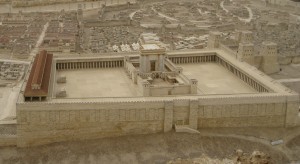The Angel Comes to the Priest Zacharias
When Zacharias goes into the temple to offer incense, he is entering the Sanctuary, which is distinct from the larger temple grounds, as indicated by the Greek term naos (in Luke 1:9), which usually points to the Sanctuary (compare Luke 23:45; Revelation 11:2). According to the Mishnah, which is a compilation of Jewish laws dating from the era before A.D. 200, a priest is allowed only once during his lifetime to light the incense. This lighting takes place twice a day at the temple, once in the morning and once about three o’clock in the afternoon in connection with the offering of the morning and evening sacrifices and the times of prayer (1 Chronicles 16:40; Acts 3:1). Because of the large number of priests, a person is selected by the casting of lots. Hence, this occasion is the most important in Zacharias’s long years of service at the temple.
The King James text says that “there appeared unto [Zacharias] an angel” (Luke 1:11). The

Temple of Solomon, model, in Jerusalem
verb is in the passive and means “an angel was seen [by Zacharias].” There is no sense of vision or dream or divinely imposed distance between the angel and the priest. Zacharias sees the angel in a firsthand, sensory way. Luke writes that the angel stands “on the right side of the altar of incense.” Here he writes from the angel’s point of view. It is the altar’s right side. Exactly in front of the temple’s veil stands the incense altar; to Zacharias’s right, or on the north, as he approaches the altar, stands the table of the shewbread, where the twelve loaves of bread sit; to Zacharias’s left rests the large candelabrum or Menorah. The angel stands between the altar and the Menorah, between the cloud of smoke and the light, symbols of the Lord’s covenant with Abraham and of His presence among the Hebrews during the Exodus (Genesis 15:10–11, 17–18; Exodus 13:21–22). Moreover, the angel stands on the south or right side of the altar, the side of promise and blessing. This position characterizes his message to Zacharias. Because of the Israelites’ orientation toward the east—the doors of the sanctuary were on its east side, for instance—the right hand is on the south. If the angel had appeared on the north side of the altar, it would have signaled bad news for Zacharias. Continue reading →


